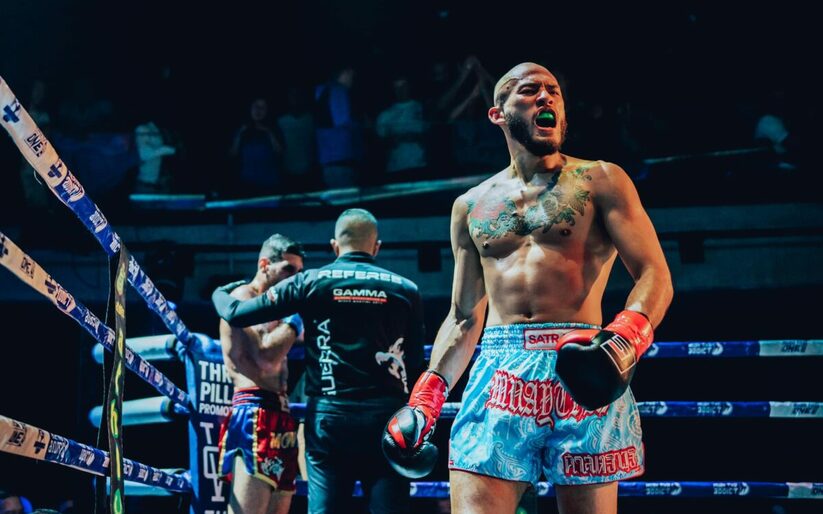This past Saturday night at UFC 177, controversy surrounded a 155-lbs main card clash between Tony Ferguson (16-3) and Danny Castillo (17-7).
After three rounds of back-and-forth action, a split call was awarded to Ferguson which garnered ‘El Cucuy’ his sixth win in the octagon.
Castillo, however, was less than impressed; The crowd, unconvinced.
“I don’t think he landed any punches, I punched him up with my boxing,” said Castillo, in his post-fight interview with Joe Rogan. “We went to the ground and he wasn’t doing anything. What can I do? I controlled a grown man and he couldn’t do anything. If we were in jail, he’d be in trouble.”
Ferguson, meanwhile, pleaded his case. He wasn’t impressed with his opponent’s grappling prowess.
“When you lay on someone like that and you’re not trying to pass and you’re chilling, the judges look at that,” the 30-year old exclaimed.
Ordinarily, prior to the decision, MMA history suggested that Castillo would have received the nod, purely based on the amount of top control he had achieved on Ferguson. While he did little damage and wasn’t able to land anything substantial, takedowns and control were definitively on his side.
Ferguson, though, was the aggressor from the bottom and on his feet, directing his focus on mixing in ambitious rolling kneebars and choke attempts. But at the same time, it was well worth noting that the 30-year-old’s carelessness on his feet often gave Castillo the opportunity to get the better of him on his feet as well.
It all then came down to the judges’ interpretation of proceedings.
If we were to ever ask judges how they evaluate takedowns and/or top control, there’s a good chance we’d get a different answer. There’s also a good chance that MMA analytics will be a handful in analyzing the judges’ decisions. But if a fight is dead even with only two potent indicators in takedowns/control and activity, it isn’t a secret that in most instances, takedowns will get fighters their hands raised.
Let’s put this in perspective: takedowns score points. And I’m referring to just the takedown in itself, and not strikes or control that comes afterward. The criteria of the Unified MMA Rules System explicitly states that control and takedowns are important facets of scoring a fight. Facets that Castillo accomplished and yet found himself on the wrong side of a decision. Was it a tad bit overboard? Perhaps so.
Being the MMA nerd that I am, I decided to engage the help of friend and veteran MMA fighter, Danielle West (4-5-1), to help dissect the situation.
“Let’s look at it in terms of a street situation; I’m being attacked and the attacker takes me down and lays on top of me or worse tries to assault me,” she said. “I’m punching and looking to disable them but they’re on top attacking me or worse sexually assaulting me. Then, I’d lose.”
“With regards to the fight, active or not, he (Ferguson) wasn’t able to finish him. I don’t think that it’s right for fighters to lay and pray but also I think that unless the fighter on the bottom escapes or submits successfully, then he isn’t controlling the octagon/pace/action. In short, the takedown artist managed the takedown and the submission artist failed to submit the wrestler.”
If you felt case in point, Castillo was screwed, let me remind you there have been worse outcomes this calendar year alone.
A recent fight that comes to mind was the 145-lbs tourney tussle between former WEC champ Miguel Torres and Takahiro Ashida under the REBEL FC flag in Singapore. Ashida landed takedowns almost at will for the duration of the contest, but it was Torres who was active off his back, always on the surge for submissions and transitions. REBEL FC uses the Unified Rules of MMA but on that occasion, despite Ashida’s top position and takedowns, the decision went in favor of Torres to the dismay of the masses in attendance.
Now before we go head over heels on this situation or blow things out of proportion, I must admit Castillo’s loss wasn’t a highway robbery to a certain degree.
Let’s be fair and take a look at this from Ferguson’s viewpoint. He’ll be glad to admit he succumbed to large amounts of top control. And while takedowns do count for a lot and show an element of control, the fighter has to advance his position once he attains the takedown. This comes under effective aggression, and can be a whole new debate altogether. Castillo failed to capitalize on that front.
While the dominant position of the person on top always plays in the minds of judges and fans alike, it’d be criminal to neglect the activity from the fighter on his back. After all, he is aggressively seeking to finish the fight, regardless of top/bottom position, and should be rewarded for his efforts. Ferguson was rewarded with a win.
However, allow me to remind you that the issue, here, does not simply lie with takedowns/control vs. activity. The judges play a huge part as well.
VALOR’s co-promoter and matchmaker, Dan Enson Hyatt (8-4-1), believes the judges are the ones to blame. He’s a fan of takedowns, but is adamant that activity from a fighter should not go unnoticed.
“I believe the problem is judging and the criteria in which judges are instructed, or better yet, expected to gauge fights,” Hyatt stated. “For a long time now, takedowns and general, low risk control have won fights in the majority of judges’ eyes regardless of activity from the back or against the fence, and this perception needs to change.”
Mixed Martial Arts is certainly difficult to judge as there are so many components to it. With strikes, takedowns, submissions, cage control and aggression being some of many things taken into consideration, it is easy to see why there may be the occasional blunder.
The toughest part of judging is undoubtedly the ground game, though. Judges have to keep a keen eye and understand what they are looking at.
But, under the Unified Rules, is a takedown better than aggression? Is top control better than activity? These are just some of the many instances judges must consider during the course of the fight.
I’m trying to substantiate one important thing and whether it’s takedowns or activity or not, we should have a common ground of judging consistency across the board. Takedowns do elicit a variety of opinions, but so does activity. So if judges in MMA decide takedowns are an important factor in winning a round from a judging perspective, it should always remain that way.
Perhaps Danny Castillo was right in feeling hard done by after all.
Follow Thinesh on Twitter (@ThineshJohnMMA), and keep up with the latest MMA news from MMASucka via Twitter (@MMASucka) and Facebook


